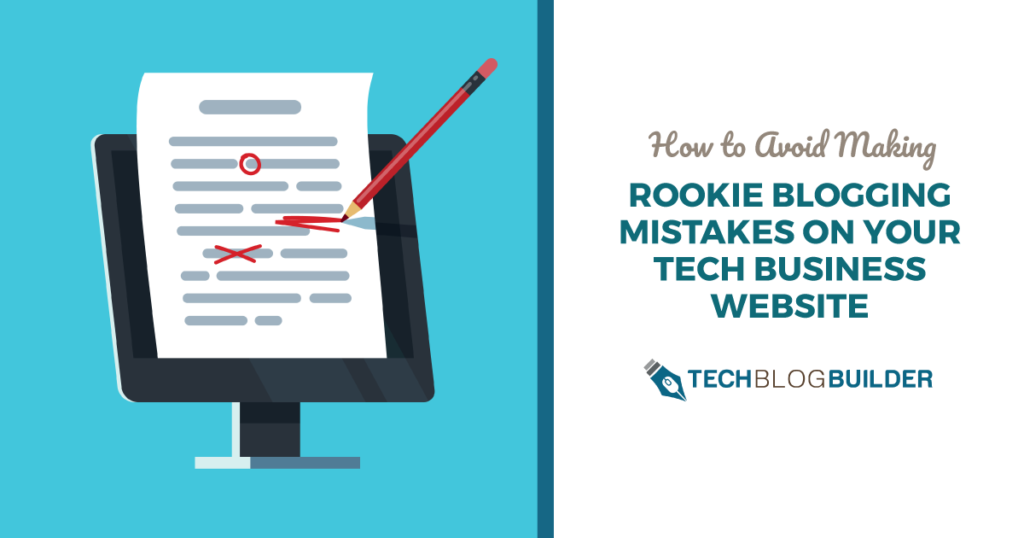Content marketing through a website blog is one of the most effective and affordable ways to generate leads for your tech business.
Not only does content marketing generate over 3x more leads than outbound marketing, it cost 62% less!
But blogging is not as simple as just writing down stuff off the top of your head. To produce solid lead generation results, you need to have a plan. You also need to avoid the following rookie blogging blunders that can leave you spinning your wheels rather than generating new leads.
Don’t Make These Common Missteps with Your MSP Site Blog
Posting blogs regularly on your MSP website provides an essential fuel for your entire marketing engine. One blog topic can give you serious mileage when it comes to leads. It can also spawn several other types of business-generating content, such as:
- Social media posts
- Videos
- eBooks
- Infographics
- Webinars
- Podcasts
- Email newsletter
Using a blog on your website isn’t really optional these days if you want to continue to generate new and recurring sales without spending a fortune on paid ads.
To be effective at small business marketing for your MSP site, you need to do a couple of crucial things:
- Appear in local search results for your services; and
- Offer helpful content that gives people a reason to visit your website regularly
Blogging regularly helps you accomplish both of those things. But only if you do it right.
Is posting a blog on my tech business site REALLY that important?
Yes! And here are a few blogging statistics that explain why:
- Leads generated by SEO have a 12.9% higher close rate than those coming from outbound marketing.
- B2B companies with blogs generate 67% more leads than those without them.
- Businesses that regularly post blogs see 2x as much email traffic from potential leads as those that don’t.
- Websites that have a blog receive 97% more links to their site and have 434% more pages indexed in search engines.
Here are the rookie mistakes to avoid to ensure your blog strategy is a success.
Not Having a Keyword Strategy
One of the biggest benefits of blogs is that they help raise your site’s relevance and your organic search engine rankings. But they can only do this effectively if you have a keyword strategy when writing your blog.
When choosing your topics, focus on keywords that are pertinent to your business. Choose one or two main keywords and then some complimentary keywords. These are other associated keywords that Google looks for when judging relevancy.
For example, if you offer Office 365 services at your tech business, you might choose a keyword strategy like this:
- Main keyword 1: Office 365 support in Austin, TX
- Main keyword 2: Small business Office 365 support
- Associated keywords: Office 365 help in Austin, support for Microsoft Office
Once you have your keyword strategy, you can use those to supercharge the SEO for your blog.
Not Capturing Leads on Blogs
If someone is interested in your content and reading your blog, once they finish, you don’t want to just leave them with “the end.” Instead, you want to capture their email address or have them contact you.
At the end of every blog, you should have some type of call to action that directs the reader to how they can get help with that particular topic or with computer support overall.
A good CTA for a blog about Office 365 would be something like:
- Looking for Office 365 help? Contact us today for a free consultation!
- Sign up for our newsletter with Office 365 Tips
- Download our “Office 365 for Small Business” eBook Now!
Not Posting Regularly
If you put up a blog whenever you have time or whenever “you feel like it,” then your content marketing strategy isn’t going to be very effective.
Studies show that the higher your blog frequency, the better your SEO and the more leads are generated.
For example, a HubSpot blog study showed that companies that published 11+ posts per month, received twice the traffic as the same-size companies that posted a minimum of 2 posts monthly.
Posting that often is usually a bit much for most small tech businesses. HubSpot recommends that companies don’t overextend themselves by trying to generate more content than reasonable.
One way to ensure a successful and ongoing blogging effort is to get help from a tech specialized blog service that writes custom blogs for you every month.
At Tech Blog Builder, we’ve found that 4 blogs per month is a “sweet spot” for most of our MSP clients. It allows them to improve SEO and lead generation, while also having time to take advantage of other related content, like social media posts and videos.

Going “Off-Topic” Too Often
Google loves serving relevant content and their Panda update a few years back brought along with it a “quality control” algorithm. Basically, this means that Google rewards highly relevant sites with good content and drops the ranking positions for sites with low quality content.
Low quality content would be content that doesn’t speak to your audience or your site’s products or services.
An example of this would be a site that decides to post Fun Facts about the world at large each Friday. These fun, off-topic posts, don’t necessarily have anything to do with computer repair, networking or technology support services.
As those posts continue to go up every Friday, Google begins to notice that the website as a whole has less “authority” when it comes to tech repair and services. Instead, it’s being saturated with unrelated content. So, Google drops the rankings for the site as a whole, even the relevant pages.
While, it’s okay to mention something off-topic in a blog every once in a while, do your best to keep those to a minimum or tie in your products or services somehow.
Not Staying Topical with Current Events
If you’re not taking advantage of current events in your blogs, they’ll become stale and you’ll look like you’re out of touch.
Proactively serving up blogs that relate to the conditions people are currently experiencing or new technology releases, keeps your readers engaged. It can be the thing that keeps someone subscribed to your newsletter or following your social media. They stay because they know you’ll keep them informed.
A few of the recent topics that are very relatable to all types of residential and business clients are:
- How to Secure Your Home Network While Working Remotely
- How Can I Safely Disinfect My Electronics?
- Using MS Teams During COVID-19 to Stay Connected
- How to Keep “Zoom-Bombing” from Happening to Your Online Meetings
Not Promoting Your Blog Content
Do you just post up a blog and hope people visiting your site will notice? Why not share it with the world?
If you take a “build it and they will come” attitude with your blog, you’ll only have a fraction of the success that you could have with your content marketing strategy.
Letting people know about your newest blog will get you the most promotional traction out of every post. Here are a few ways to spread the word:
- Social media posts
- Posting as an article on LinkedIn
- Highlighting new blogs in an email newsletter
- Including certain blogs in an email drip campaign
- Include your blog URL on your quotes, invoices, email receipts, etc.
Not Using a Compelling Image
If you want people to engage with your blog, you need to have at least one or more compelling images. Images break up the text of longer blogs and give people a visual to connect to the content of the article.
Blogs with images get 94% more views than those without them.
Take your time choosing the right image and don’t just put up the first stock photo that pops up on a keyword search. It’s also often worth it to add your logo to the corner of the header image you’re using. This ensures your branding will be visible when the content is shared.
Here are some great tips on choosing the best images for your website and blog.
“Borrowing” Content Without Permission
In a rush to get content posted, you don’t want to plagiarize someone else’s blog by copying it and only changing a few words.
There’s no reason you can’t get topic ideas from another tech business site, but make sure that the content you post is completely original. You’d be surprised how many different angles you can take on a topic!
Not only is copying someone else’s content not cool, you can also get dinged in your search rankings by Google for it.
Forgetting About Your Blog Post Once It’s Online
Those new to blogs, often post their content and then move on. Never revisiting that blog again. This is a mistake.
Refreshing older blog posts has several benefits, including:
- Gaining more website traffic
- Improving SEO for an older blog
- Updating information that has changed
- Giving you “new” content for a small investment of time
Refreshing an older blog is like refurbishing a kitchen. The main structure remains, but you’ve given it a fresh look.
Marketing company, 6Q, found that their page views on a post increased 209% after refreshing their blogs.
Tips for refreshing content include:
- Don’t delete the keywords for SEO
- Update any outdated information (i.e. a software feature)
- Add a little more “meat” to the article
- Add “(Updated YEAR)” at the end of the blog title
- Resend the updated blog out over your marketing channels
It’s important to make a note that the blog has been updated and when to let readers know. I often see this tactic used when doing research. It let’s me know that I want to look at that post for new information, even if I may have read it a few years ago.
Not Taking the Time to Plan a Blog Strategy
Many rookie bloggers think up a topic as they’re writing, without coming up with an overall blog strategy.
This can lead to you posting five blogs over two months about phishing, but none about your remote support services.
It’s a good idea to do a blog planning calendar and take a little time each month to fill up the next month’s topics. This will help you ensure an even coverage of topics that speak to your customer groups. It will also help you better take advantage of topics relating to current events, software releases, or new services you’re offering.
Do Blogging Right & Reap the Benefits
Business owners that don’t see success from their blog usually aren’t giving it enough time or are making rookie mistakes. Learn how to do blogging right and you’ll see the benefits in search ranking and lead generation.
What are your biggest blog challenges? Share in the comments!


